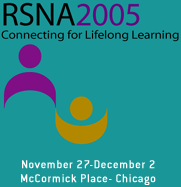
Abstract Archives of the RSNA, 2005
Suk Kim MD, Abstract Co-Author: Nothing to Disclose
Im Jeong Seo MD, Presenter: Nothing to Disclose
Jun Woo Lee MD, Abstract Co-Author: Nothing to Disclose
Yeon Joo Jeong MD, Abstract Co-Author: Nothing to Disclose
Gwang Ha Kim, Abstract Co-Author: Nothing to Disclose
Do Youn Park, Abstract Co-Author: Nothing to Disclose
Benign ulcer has necrotic fibroid debris in the ulcer crater. In contrast to benign, malignant ulcer has cancerous crater. Considering this concept, we evaluate to determine the CT criteria for differentiating benign from malignant ulcer.
18 clinicopathologically proven benign ulcers that had been detected by both endoscopy and CT were enrolled in this study. As controls, 26 ulcerative advanced gastric cancers and 26 early gastric cancers with ulceration, which had been surgically proven, were selected by random sampling in the pathologic data base. CT images were assessed by two radiologists who were unaware of the clinical and pathologic findings and who reached a consensus about the imaging findings (size of ulcer, degree of gastric wall thickening, presence of discernible thick-walled ulcer base, degree of contrast enhancement of ulcer base, presence of transmural enhancement, presence of extension of the ulcer into or beyond the body of the stomach, perigastric fat infiltration, and perigastric lymphadenopathy). Statistical analyses were performed with Fisher exact test followed by Bonferroni’s correlation for multiple comparisons.
Five of 26 early gastric cancers confined in mucosa were undetected on CT. Retrospectively, indiscernible thin-walled ulcer base, suboptimal enhancement of ulcer base and extension of the ulcer into or beyond the body of the stomach were significantly useful in benign peptic ulcer. Indiscernible thin-walled ulcer base (less than 1.5 mm) showed the highest specificity 100% with 89% sensitivity. Suboptimal enhancement of ulcer base also showed the high specificity 97.9% with 72.2% sensitivity. The finding of discernible thick-walled ulcer base (more than 2mm), mild to intense contrast enhancement of ulcer base and transmural enhancement is highly specific finding of malignant gastric ulcer. The perigastric infiltration and perigastric lymphadenopathy were not significant findings for differentiation of benign gastric ulcer from advanced gastric cancer with ulceration.
Indiscernible thin-walled inner layer with suboptimal enhancement in the ulcer base could be a sensitive and specific for diagnosing benign gastric ulcer.
Kim, S,
Seo, I,
Lee, J,
Jeong, Y,
Kim, G,
Park, D,
CT Differentiation of Benign and Malignant Ulcers of the Stomach. Radiological Society of North America 2005 Scientific Assembly and Annual Meeting, November 27 - December 2, 2005 ,Chicago IL.
http://archive.rsna.org/2005/4413211.html

